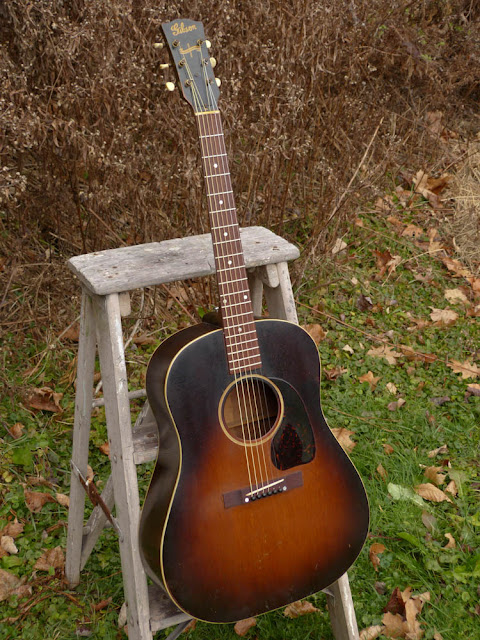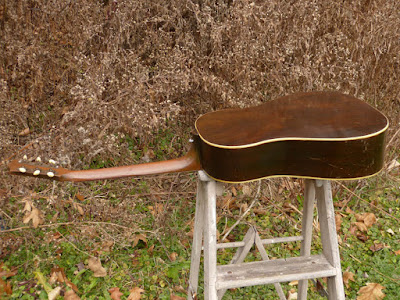1944 Gibson "Banner" J-45 Slope Dreadnought Guitar
There's no way around it -- this is an awesome guitar. It's a desirable "banner" model, has a truss rod, no cracks, and also the oddball mahogany top one finds on Gibsons as an alternative to the hard-to-find spruce during wartime. The sound is tremendous -- just as you'd expect it -- and it plays right on the dot.
Work included a board plane and refret, new bridge, general cleaning, and a good setup. I also managed to reuse the original nut and saddle (bone). It plays like a boutique-style reissue of one of these -- quick, fast, easy, and sure -- yet it's not a reissue. This is the real deal and it has the boomy, outboard voice to claim that reputation. I jammed on this all night on Thursday and it certainly cuts right through the mix. Boom, boom, boom! Yet -- the mahogany top gives it a woody clarity that's familiar but different from the spruce-topped '43 J-45 I had earlier this year.
Update: Q&A: the factory order number (FON) is 26xx.
Update: Q&A: the factory order number (FON) is 26xx.
I was amazed to find all the bracing perfectly tight and good-to-go inside. Did I mention the top and back are both one-piece slabs of 'hog? Not to mention that burst looks so tobacco-delicious on the 'hog as well...
The finish is all original (with that nice weather-check) on the body but the neck was oversprayed (even on the fretboard). Here's a link to the blog post that showed the "before."
While the headstock has a coat of overspray, it still looks grand. The tuners are all original and aside from one knob being just a hair bent, are in good order. The nut is the original bone one, the truss rod functions perfectly, and the neck is stable, straight, and good to go. This has a just-barely 1 3/4" nut width.
Update: It was mentioned to me that this might be a gumwood fretboard rather than rosewood. It looks like it when compared to others I've pinged around on the net -- so thanks for that tip-off! It reminded me (after buffing-up) at a glance of some of the weird rosewood Regal sometimes used in the late 40s.
It was so nice to take the board back to its original wood -- this is very plain-Jane stuff and the level/dress job on the board itself also pulled out some gorgeous tones in the pearl dots. I refretted this with brand new medium-height, "vintage" width frets. These feel wonderful and will take many, many level/dresses for the future.
It was so nice to take the board back to its original wood -- this is very plain-Jane stuff and the level/dress job on the board itself also pulled out some gorgeous tones in the pearl dots. I refretted this with brand new medium-height, "vintage" width frets. These feel wonderful and will take many, many level/dresses for the future.
Action height is spot-on at 3/32" E&A and 1/16" DGB&E at the 12th fret. This is strung with a set of 12s and I can't wait to hear this guitar after the initial "new strings" thing wears off.
The original pickguard shows a little finish-gassing around its edges and a polished-up (pickwear/fingerwear) bit in the middle. Classic Gibson!
This looks very, very close to an original bridge and I bought a whole heap of these online (lest they disappear) from a vendor who was selling various back-room vintage parts (including NOS Martin classical bridges and the like). I'm fairly sure these are NOS Gibson bridges from the 50s/60s. They appear to be Brazilian. At any rate, it's much like the original (same dimensions and string spacing) save the saddle slot is drop-in (players often prefer this, collectors can be finicky -- I absolutely prefer them as setup is a breeze). Saddle/bridge height is actually dialed-in exactly as it was on the original bridge and I've re-used the original bone saddle (now shaped and compensated) on this one. The saddle had been a little chewed-up from small slots cut into it when this had a trapeze tailpiece installed.
The pins are new ebony ones and the pearl dots do not have bolts hidden under them like the original mounting would have.
Update: Q&A time: The reason the bridge is swapped is that I don't trust split original bridges for reuse. I've glued up enough old ones to know they tend to split once again. Also: this new bridge has slightly softer shoulders and a bare finish that's not original to the bridge itself as I was matching it closer in looks to the board. The original (damaged) bridge comes with the guitar.
Update: Q&A time: The reason the bridge is swapped is that I don't trust split original bridges for reuse. I've glued up enough old ones to know they tend to split once again. Also: this new bridge has slightly softer shoulders and a bare finish that's not original to the bridge itself as I was matching it closer in looks to the board. The original (damaged) bridge comes with the guitar.
I love, love, love the look of that checking.
Here's some honest "arm wear," too.
I know, right? It's gorgeous.
I had to replace one missing tuner screw. These are the original Kluson units.
Note the yellowed overspray on the back of the neck. There was also a black strap button installed in the heel -- I took it out in favor of chrome, though I could also just fill it in per customer request.
The overspray on the back of the mahogany neck does not distract and feels natural under the fingers. I was thinking of sanding it down and "speed necking" the guitar, but will leave such things up to the next owner to decide.
Like I said -- the action is spot-on. There's a slight visual illusion here caused by the tall frets and slightly in-board string spacing (standard for Gibs from the time), though. If you've never played an old Gib like this after freshly refretting -- it's joyous.
A missing endpin got replaced with a new ebony one. Note the old holes for a trapeze tailpiece (40s stock) that was installed in the past.



























Comments